What to Wear in Iceland in Winter (October-April): Packing List & Tips
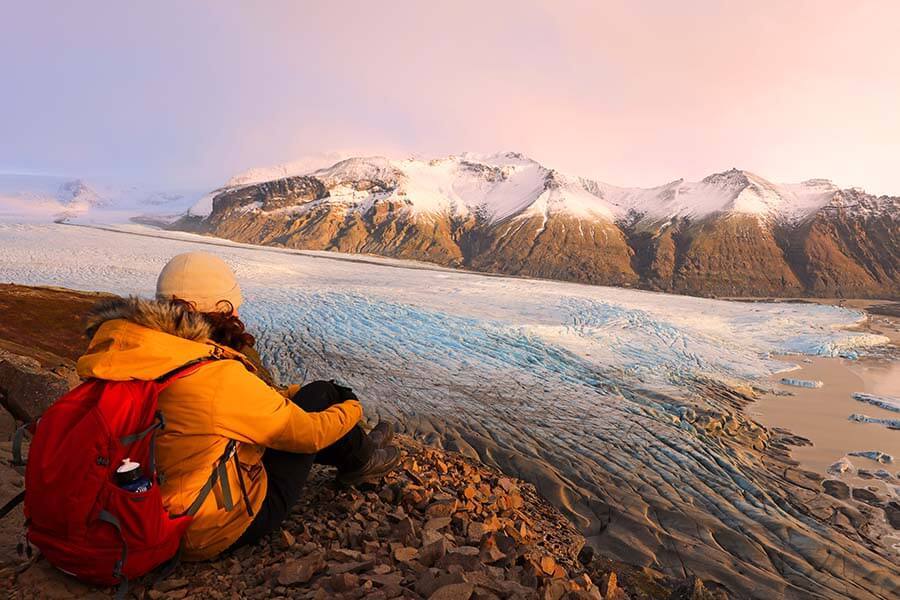
This site contains affiliate links, which means that we may earn a small commission, at no cost to you, for qualifying purchases. It supports the work that goes into keeping this content free. Thanks for reading! More info: Privacy Policy.
Traveling to Iceland in winter and wondering what kind of weather to expect and what to wear in Iceland in winter (October, November, December, January, February, or March and even April)? Or maybe you are looking for tips on what to pack for Iceland in winter? This article should answer all your questions.
Whether you want to know what to wear in Iceland in November, December, January, or February, or what to pack for Iceland in October or March, this Iceland winter packing list contains all the information that you need in order to truly enjoy your Icelandic winter adventure.
It’s the most complete no-nonsense Iceland winter packing list out there. I include all the tips on what to wear in Iceland in winter and other items that you really shouldn’t forget. In addition, I share my personal experience and examples of what I wore in Iceland in November.
At the bottom of this article, you can also find some tips on what to wear in Reykjavik in winter. If interested, you can also download a printable version of this Iceland winter packing list. Read on!
Good to know: Just to make it clear, by winter in Iceland I don’t just mean November, December, January, and February. Icelandic winter is much longer than that! So this Iceland winter packing list has all you need to pack when traveling in Iceland between the end of September till the end of April. For the rest of the year – check our Iceland packing list for summer.
How cold is it in Iceland in winter?
You may wonder how cold is it in Iceland in winter. It’s actually warmer than you would expect – average temperatures in Reykjavik are around 0°C (31°F) in January. However, don’t let that fool you – the wind makes it feel much colder than the temperatures would make you think.
On top of that, Icelandic weather is known to change quickly and often. Usually, you will get more rain than snow and cold northerly winds which can be very strong. Iceland is really very cold in winter. When traveling to Iceland in winter, you really need to dress as warm as you possibly can.
I can’t stress this enough – you have to be prepared for everything when traveling in Iceland, especially in the cold months. So I created this Iceland winter packing list in order to help you prepare for your trip and make the most of it, no matter the weather. Find out!
READ ALSO: Essential Tips for Iceland in Winter
What to wear and what to pack for Iceland in winter
Icelanders will tell you that there is no bad weather, just bad clothing. But what kind of clothes to wear in Iceland in winter? You might be looking for specific advice on what to wear in Iceland in November or what to wear in Iceland in December or in January or in October or even March….
The reality is that it doesn’t matter that much in which month you are traveling specifically. Winter packing list for Iceland is pretty much the same whether you are visiting in October, January, or March.
Packing for Iceland is tricky because you can expect so many different weather conditions in any season. In a way, it’s easier to pack for Iceland when visiting in winter months than in the shoulder season or even in summer, because you know that no matter the weather, it will always be cold. Hope for the best but prepare for the worst!
My best advice for what to wear in Iceland in winter is this: dress in LAYERS, ideally WOOL, and always wear a WINDPROOF and WATERPROOF outer layer. Dressing in layers gives you a lot of flexibility for any weather conditions.
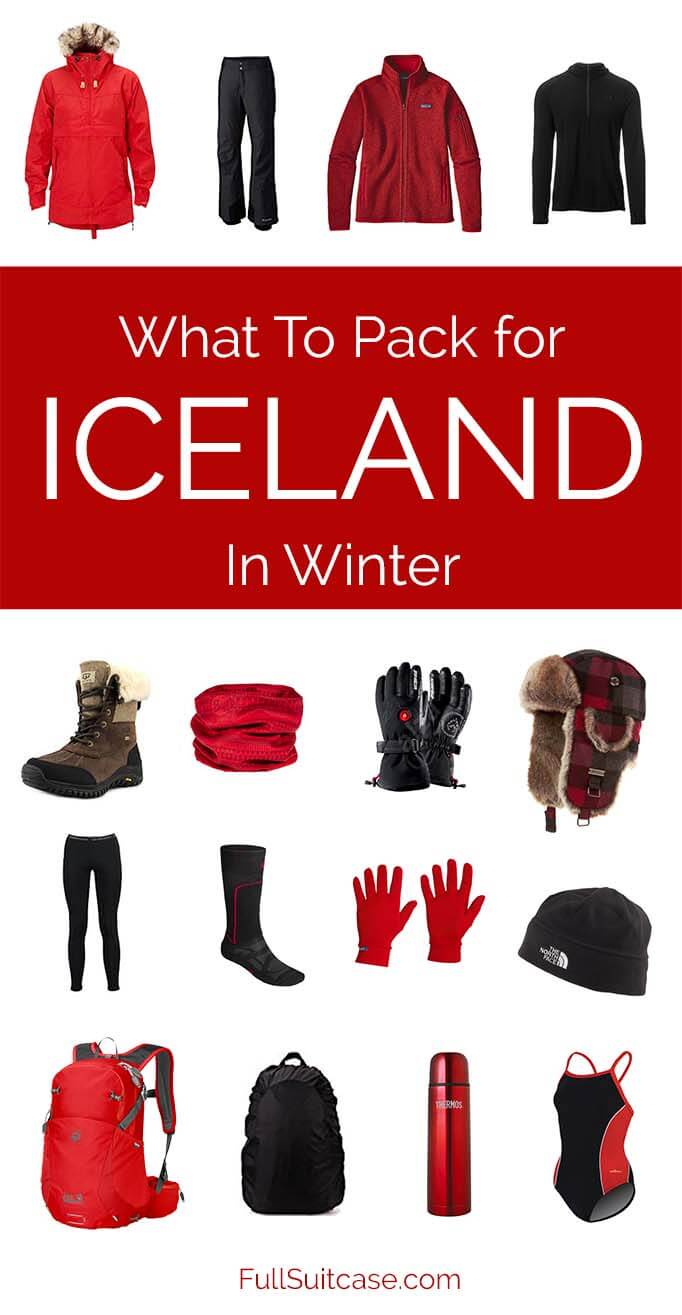
Without further ado, here is the most complete packing list for Iceland in winter:
Waterproof winter jacket
Waterproof and windproof winter jacket. You do need an insulated waterproof and windproof winter jacket in Iceland. It’s an absolute must!
If you don’t have a very warm jacket, it’s not a problem to wear a somewhat thinner waterproof jacket. For example, a ski jacket will usually do just fine. Just make sure to wear several layers of fleece and/or woolen sweaters underneath.
It doesn’t really matter if you are visiting Iceland in October, November, January, or even in April,- you do need a really warm waterproof winter coat or a parka for Iceland.
TIP: Check for winter gear on Amazon – they have a good selection of waterproof winter jackets and very competitive prices. We always manage to find excellent deals. Brands like The North Face and Fjällräven are among the best ones for a quality winter jacket that will keep you warm and dry in Iceland in winter.

Thermal underwear
Thermal underwear is a must in Iceland in winter. Ideally, wear thermal base layers in Merino wool. Don’t forget leggings too. Good thermal underwear is essential when packing for Iceland in winter.
I even wore my Merino underwear when I visited Iceland at the beginning of September. In November, I wouldn’t have survived without it.
Ideally, you pack at least 2-3 pairs of thermal underwear. It’s usually quite easy to wash it by hand at the hotel and the heaters are so warm that it dries in no time. But if you are not willing to wash it, you might want to pack a clean thermal shirt for each day. It’s cold outside, but very warm in hotels and restaurants, so it will be sweaty faster than you think.
I personally own various sets of Merino underwear from the Icebreaker brand. It’s not cheap, but we travel a lot (also in winter) and I find that the quality pays off. But there are also other, more affordable brands that have good quality wool underwear (take a look here).
And if Merino wool underwear is above your budget (or you only need it for this one trip and just don’t feel like spending that much money on something you’ll only use once), there are also lots of other, more affordable options for synthetic thermal underwear.
Wool or fleece sweaters
Woollen and/or fleece sweaters. Layering is the key to staying warm in the cold and ever-changing climate. I advise wearing at least one really warm woolen sweater.
Ideally, pack a couple of thinner lightweight sweaters in wool as well. Fleece sweaters are okay for layering too, but you’ll quickly realize that real wool is irreplaceable.
Waterproof winter pants
You should know that jeans are completely useless in Iceland and even more so in winter. They’ll get wet when it rains (it will rain!) and you’ll be cold and wet the whole day. You can still pack a pair of jeans to wear in the hotel in the evening but don’t wear them for exploring during the day.
Waterproof or water-resistant winter pants is what you need to pack for Iceland in winter. I didn’t buy any special winter pants when packing for Iceland in November, but took my waterproof ski pants. They were ideal for sightseeing during the day and perfect when chasing the Northern Lights at night.
You may not want to wear ski pants in Reykjavik city, but they are really essential when exploring Iceland’s natural landmarks in winter.
An alternative is to wear warm winter pants like these and pack light rain pants with you. You can quickly slip on your rain pants over when it starts to rain or snow.

Wool socks
Wool socks are essential when packing for Iceland in winter. Pack several pairs of really warm socks, especially if you are planning on spending a lot of time outdoors. I often wore two pairs of socks in Iceland in winter, at least one pair in wool; the other pair – my warmest ski socks.
Even if you can’t find 100% wool socks, any socks with some wool are incomparably better than the ones made of cotton. These are good quality merino wool socks for men. And this is a nice selection of warm wool socks for women (I personally own these and wear them at home in winter as well; they’ll be great for Iceland in winter too).
TIP: Wool socks also make a great Nordic gift for your travel companions (and not just for the Iceland winter trip)!
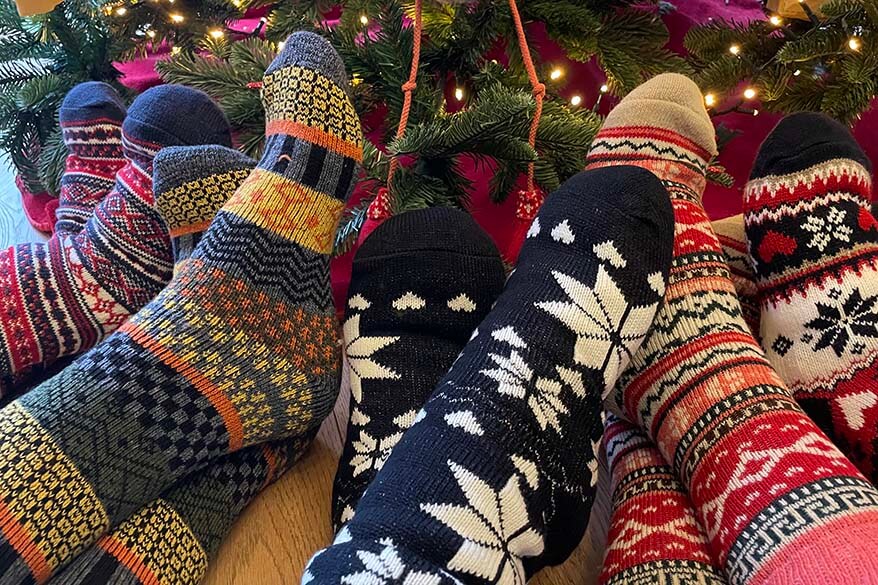
Waterproof winter boots
Waterproof winter boots. Comfortable sturdy waterproof walking shoes with good traction are a must. I wore these waterproof insulated women’s boots (alternative for men – men’s boots). You may also want to read our guide to the best winter boots for travel.
Whatever you choose, don’t compromise on footwear when packing for Iceland in winter. Once again, you really need WATERPROOF winter boots in Iceland between mid-October and March.
If you are traveling at the beginning of October or in April, you may be ok with regular waterproof hiking boots, but make sure to pack some really warm socks.
Good to know: Sturdy hiking shoes are also a must when planning to go glacier hiking in Iceland. Your shoes have to fit heavy crampons (which are provided by tour companies), so you can’t do it with simple leather shoes or sneakers.
Ice cleats or stabilicers
Iceland is really icy in winter and sometimes it’s really difficult to walk around, even if you have good winter boots. There is one thing that I missed in Iceland in winter and that is stabilicers (aka shoe spikes or snow grips) – a sort of an extra shoe sole with steel cleats to prevent you from slipping. We could have definitely used these by the waterfalls!
STABILIcers for walking on ice are really essential in Iceland in winter. I see this question asked again and again – do I really need shoe spikes in Iceland in winter? Yes, it’s really a good idea to pack shoe spikes or ice cleats for outdoor activities in Iceland in winter.
There are lighter and cheaper models (e.g. like this) that don’t take up much space in your suitcase – it’s better than nothing. Pack them with you, especially if traveling to Iceland in the coldest months from November to March.
Waterproof gloves, winter hat, and a scarf
Gloves, scarf or buff, and winter hat. Gloves, a scarf or a buff, and a winter hat are an absolute must in Iceland in any season. In winter, I advise wearing warm windproof and waterproof GoreTex gloves, ideally mittens, together with thin inner gloves that you can keep on while taking pictures.
I packed two warm hats to Iceland with me as well: a fleece hat and a winter hat with ear flaps. I used them both – the fleece hat during the day when it was dry and the waterproof hat when the wind was really strong, when it rained, and also at night when waiting for the Northern Lights.
Swimsuit and a quick-drying towel
A swimsuit and a quick-drying towel are a must in Iceland in any season. Iceland is known for its many outdoor thermal pools and hot tubs which are popular all year round.
Although you can usually rent a towel at some bigger pools, it’s quite expensive. Smaller local pools usually don’t rent towels. It’s so much easier to just bring your own!
Regular bath towels are heavy and take a long time to dry. I recommend packing a quick-drying travel towel. Also, don’t forget your swimsuit! Flip-flops might be useful but are not a must.
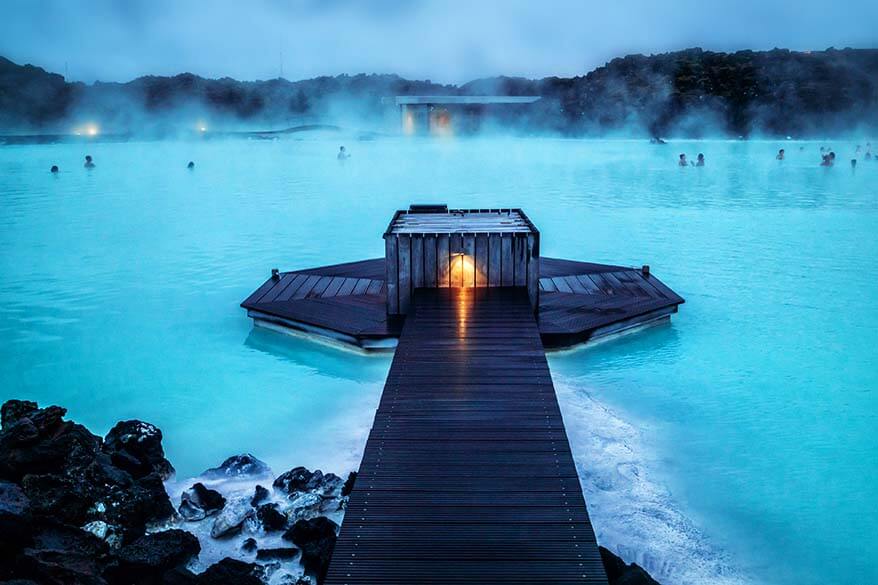
Jeans/ pants
I already mentioned that jeans are not ideal for Iceland. However, you may want to pack a pair of jeans or light pants to wear on the plane or at your hotel/restaurant in the evening.
Whether or not you need smart clothing depends on where you are staying in Iceland. You may want to pack one set of casual smart clothing to wear for dinner or to go out in Reykjavik. In general, people dress very casually in the hotels in Iceland – a pair of jeans and a sweater is all you need.
Extra pair of shoes
I also recommend packing an extra pair of shoes when traveling to Iceland. After all, you don’t want to wear your muddy and wet winter boots inside a hotel. It’s also essential to have a second pair of shoes in case your boots get really wet.
Winter jacket, wool sweaters, and a swimsuit? Yes, this is what you should pack for Iceland in winter!
Further below you can find a list of other Iceland winter packing essentials (not clothing) that you really should pack for Iceland in winter. At the bottom of this post, you can also find some examples of what I wore in Iceland in November. Read on!
Thermos
Thermos flask. There are few things in life that make you feel better than a sip of a hot drink after a walk in the cold. And even though there are many more cafes and restaurants in Iceland now than there used to be when we visited ten years ago, finding one while on the road can be trickier than you think.
Packing a thermos flask (and a picnic lunch for that matter) gives you complete flexibility during the day. You can fill it up with coffee or tea at breakfast in your hotel or at a petrol station or a restaurant.
Find a beautiful spot, sit down on a rock with a warm cup of tea in your hands and a magnificent view in front of you – it’s as good as it gets.
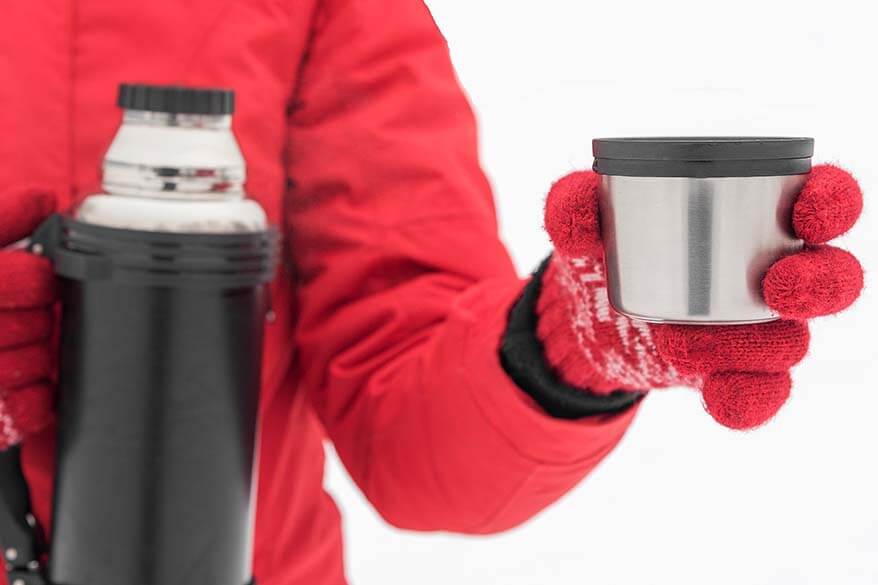
Reusable water bottle
Reusable water bottle. Icelandic tap water is pure, it’s tasty, it’s safe to drink, and it’s FREE. Take a reusable water bottle and fill it up whenever you can.
Flashlight
Flashlight or headlight. Having a small powerful flashlight in your pocket can be very useful on many occasions as it gets dark very early in Iceland in winter. We used flashlights all the time when looking for a good spot to photograph the Northern Lights or when trying to choose the right camera settings or to focus in the dark. The headlamp flashlight keeps your hands free, so it’s ideal for night photography.
Moisturizer
Lip balm, hand cream, face cream for cold weather, and body moisturizer should be in everybody’s bag when traveling to Iceland in winter.
You will enjoy your Iceland winter trip more when you don’t have cracked lips, dried-out hands, or an itching body. Take my word for this, you’ll be glad you packed these little travel essentials.
Washcloths
If you often use washcloths at home, you may want to pack a few for your trip to Iceland. Many of our American readers said they were surprised to find out that Icelandic hotels don’t provide them.
Coming from Europe, we don’t expect to find something like that everywhere we go, so I never even thought of it. But since so many of our readers mention it, I now updated this packing list to add washcloths.
Camera gear and tripod for aurora photography
Weather-resistant camera gear and a sturdy tripod. You should not forget to bring your camera gear. If your budget allows it, consider a weather-resistant camera for Iceland.
A good tripod that can withstand strong wind is a must for night photography.
Here you can find more tips for finding and photographing the Northern Lights. And here you can find our travel photography tips.
READ ALSO: How to See Northern Lights in Iceland
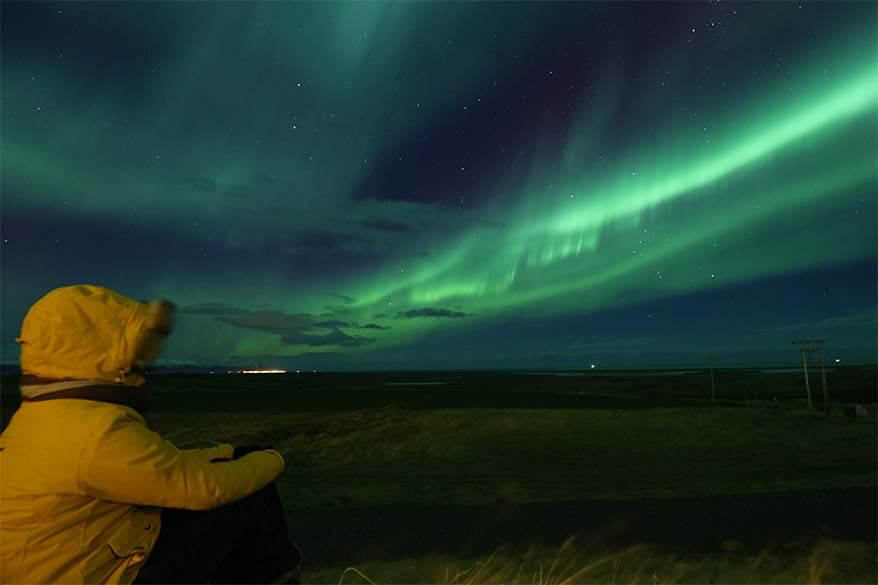
Power bank
Batteries drain very fast in a cold climate. I advise you to carry extra batteries for your camera in Iceland in winter and don’t forget a good power bank/ portable charger. It allows you to charge your smartphone or any other device during the day. A power bank has quickly become my essential packing item for all our trips.
Travel adapter
Iceland uses European plugs. Regular European travel adapters will be fine for charging phones and cameras, but not for heavy devices such as hair dryers.
Sunglasses
Yes, you also need sunglasses in Iceland in winter. The sun is very low and you’ll definitely need sunglasses if driving on a sunny winter day. If you have special sports anti-fog sunglasses, you may want to take those with you. Otherwise, just take your regular sunglasses, just in case.
Backpack with rain cover
Day backpack and backpack rain cover. A good rain cover for your backpack is a must when visiting Iceland in any season. When it rains, it pours and in a matter of just a few minutes, everything is soaking wet. You can leave your umbrella at home – strong winds make it completely useless.
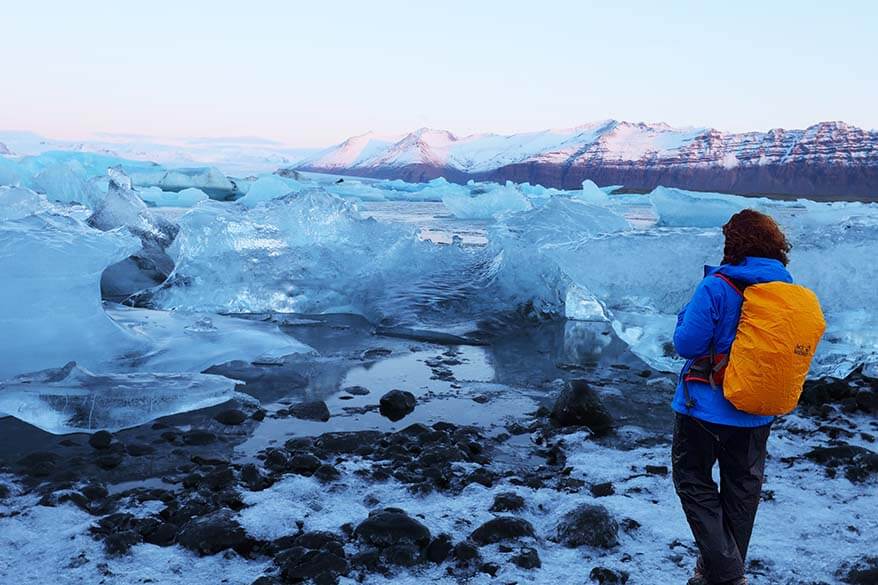
Medication
Traveling in Iceland usually means that you’re in very rural locations with no shops, let alone pharmacies nearby. Make sure to pack a first-aid kit and any medicine you think you might need. As a minimum, make sure you have some strong pain medication with you.
Ice scraper
When renting a car in Iceland in winter, you may want to pack an ice scraper. I still can’t believe it, but rental cars in Iceland don’t come with any winter essentials. So, as a minimum, pack a (small) ice-scraper with you. I heard from many people that they advise to also take a foldable snow shovel, as well as a brush to clean the snow off the car, but we never packed one.
In fact, we didn’t have any of these items on our trip to the North of Iceland in May. However, it snowed so much that our car was covered with snow. Luckily we were able to borrow a big brush from our accommodation – see the picture below.
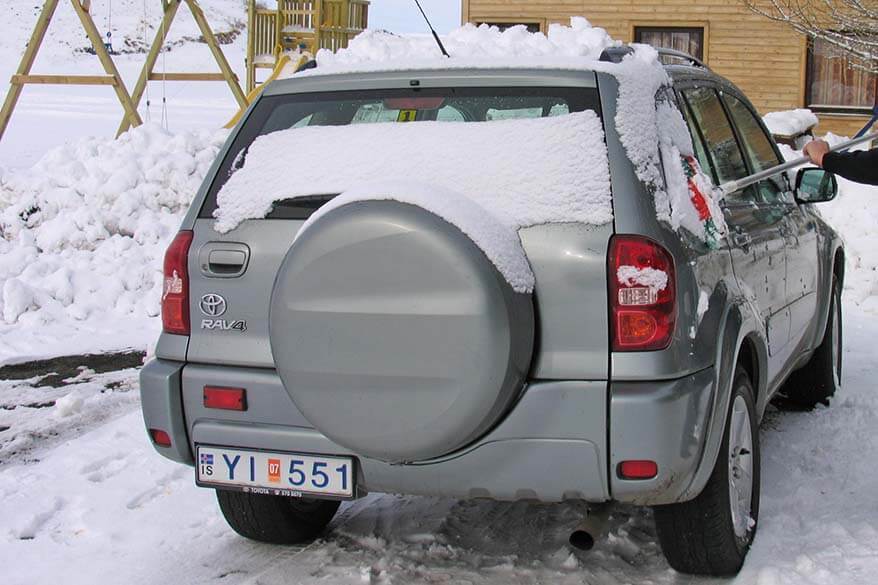
What to Wear in Iceland in Winter – My Experience in November
If you’re looking for specific advice on what to wear in Iceland in winter, here are some examples of the clothes that I wore on my trip to Iceland in November.
We had very cold weather, with temperatures dropping to -10°C (14°F) and winds up to 100km/h (62 mph) on several occasions.
We asked Icelanders what they thought the wind chill factor would be, and they said there was no number to describe it. When it comes to Icelandic winter weather, they said, you can only divide it into two categories: cold or bloody cold. It was the latter.
So here are some examples of the clothes that I wore, and which allowed me to actually enjoy my Icelandic winter trip:
- Insulated waterproof- and windproof winter jacket (like this).
- Insulated waterproof winter pants (like this).
- Merino underwear (long-sleeved shirts and leggings like this).
- Wool sweaters and a couple of fleece sweaters for layering.
- Two pairs of gloves – one pair of thin gloves which I wore under the waterproof ski mittens.
- Thermal buff + a warm thick scarf.
- Two hats – a fleece hat for dry days and a winter trapper hat for when the fleece hat wasn’t warm enough.
- Wool ski socks.
- Waterproof winter boots.
Please note that the clothing I linked to is similar to what I wore but models/brands/styles change all the time, so it’s not always possible to link to the exact same products. Anyway, this should give you a better idea of what to look for when packing for Iceland in winter.
Printable Iceland Winter Packing List
If you are looking for a printable winter packing list for Iceland, you can fill in the form below, and you’ll be able to download a pdf file with all the essentials.
This printable winter parking list for Iceland has all of the items listed above and makes it easy to check if you haven’t forgotten anything.
Because, well, you really don’t want to arrive in Iceland in winter and realize that you left your thermal undies or waterproof gloves at home…
If you forget to pack something essential… You will be able to find anything you might need in Reykjavik and some bigger towns in Iceland, but it is really difficult to impossible in rural areas.
Also, the prices are much higher in Iceland than on Amazon. So it’s best to prepare well in advance, pack everything you need, and enjoy the trip of a lifetime!
What to Wear in Reykjavik in Winter
If you are wondering what clothes to pack for Reykjavik in winter months, I think the answer depends on what you’re planning to do. If you are just visiting the main attractions in Reykjavik city, going to museums and shops, then you don’t really need ski pants or several layers of sweaters.
Warm winter shoes are still a must, as well as a good winter jacket, gloves, scarf, and a hat. Insulated water-resistant pants are still advisable.
On the other hand, if you are planning to do winter day trips from Reykjavik, then you should dress really warm and follow our Iceland winter packing suggestions from this post.
READ ALSO: Best Area & Hotels to Stay in Reykjavik
Planning a winter trip to Iceland? Take a look at these guides as well:
- Useful tips: Travel Tips for Iceland in Winter
- Winter Itinerary Suggestions: Best Iceland Winter Trip Itinerary
- Winter bucket list: Things to Do in Iceland in Winter
- Driving: Driving and Roads in Iceland in Winter
More tips for your trip to Iceland:
- Airport transfers: How to Get to Reykjavik from Keflavik Airport
- Budget: How Expensive is Iceland (& How to Save Money)
- Hotels: Where to Stay in Iceland
- South Coast: 4 Days in Iceland – Itinerary & Best Iceland South Coast Attractions
- Southwest: 7 Days Iceland Itinerary
- Ring Road: Complete Iceland Ring Road Itinerary
- Reykjavik: Best Half Day Tours from Reykjavik & 1 Day Reykjavik Itinerary
- Must-see: Perlan Museum in Reykjavik
- Auroras: How to See and Photograph the Northern Lights
- More: Check our Iceland travel guide for even more inspiration and tips.
Some of our favorite lesser-known places in Iceland:
- Reykjanes Peninsula – Near Reykjavik
- Haifoss Waterfall – Close to the Golden Circle
- Snaefellsnes Peninsula – West Iceland
- Glacier Hiking in Iceland – South Coast
- Heimaey Island – South Iceland
- Myvatn – North Iceland
- Siglufjordur – North Iceland
- Grafarkirkja, Road 76, and Hofsos Pool – North Iceland
- Hvitserkur – North Iceland
- Westfjords – a hidden gem off the beaten path
- Dynjandi Waterfall – Westfjords, the most beautiful waterfall in Iceland
- Raudisandur Beach – Westfjords
If you found this post useful, don’t forget to bookmark it and check it once more when packing for your Iceland winter trip. Are you on Pinterest? Pin these images!
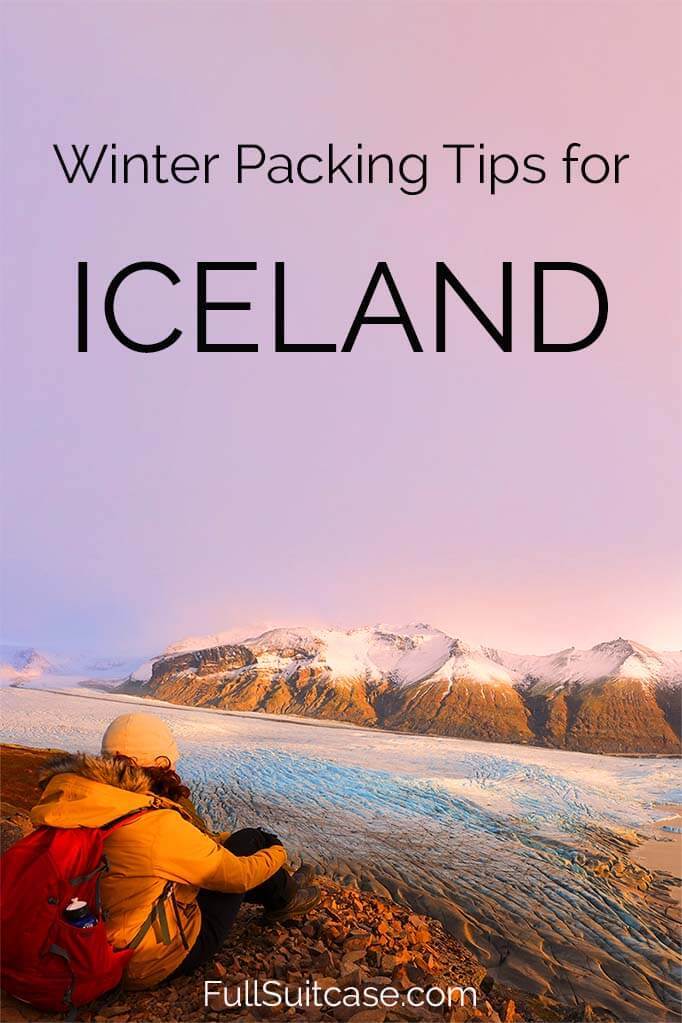
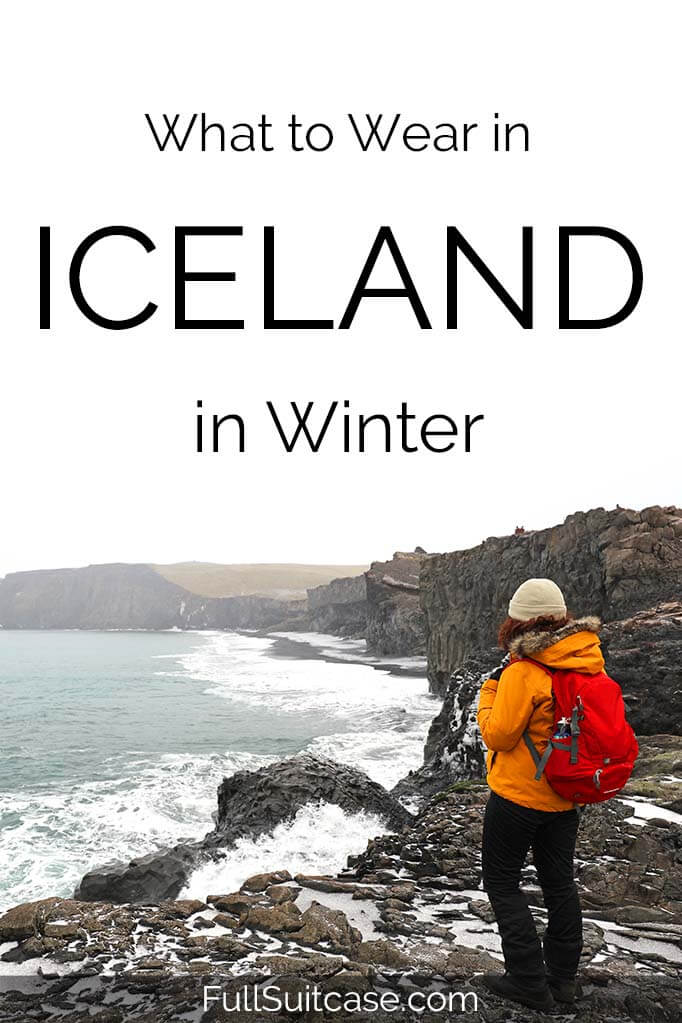

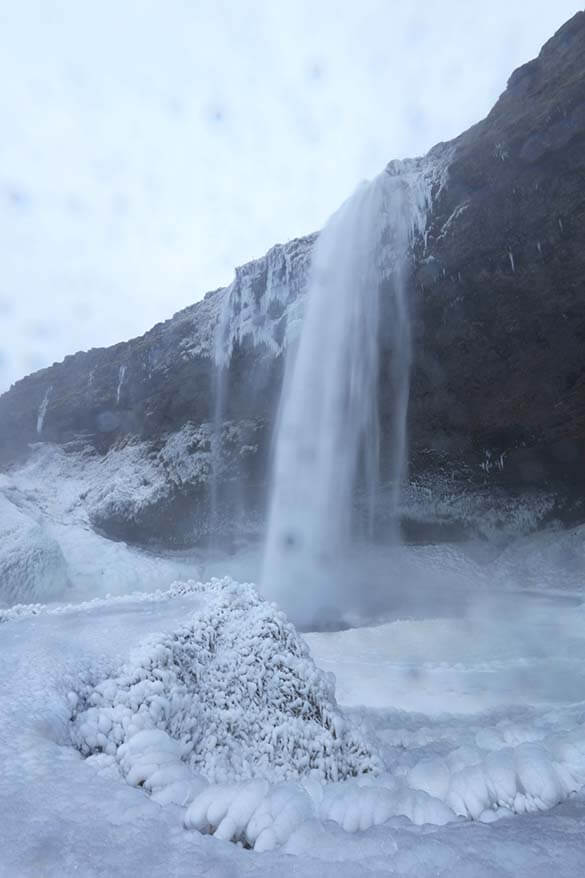
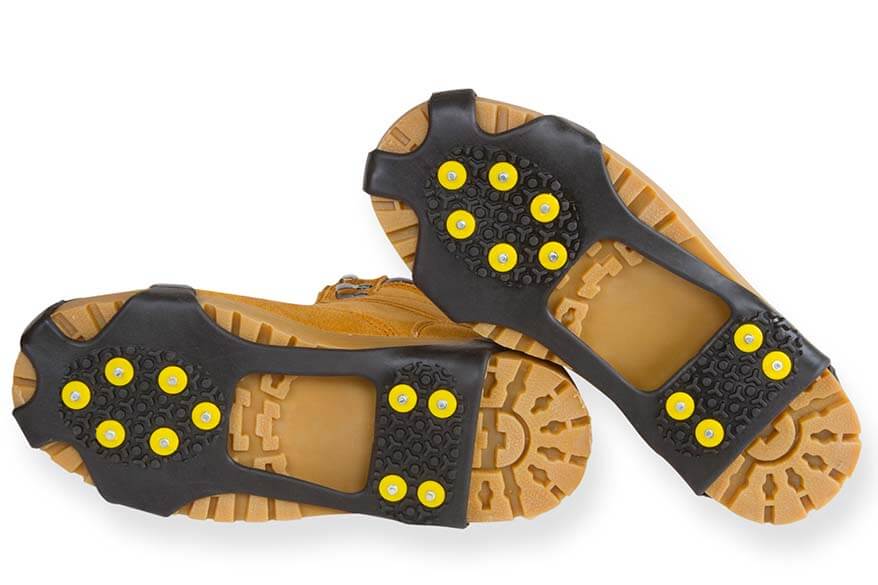
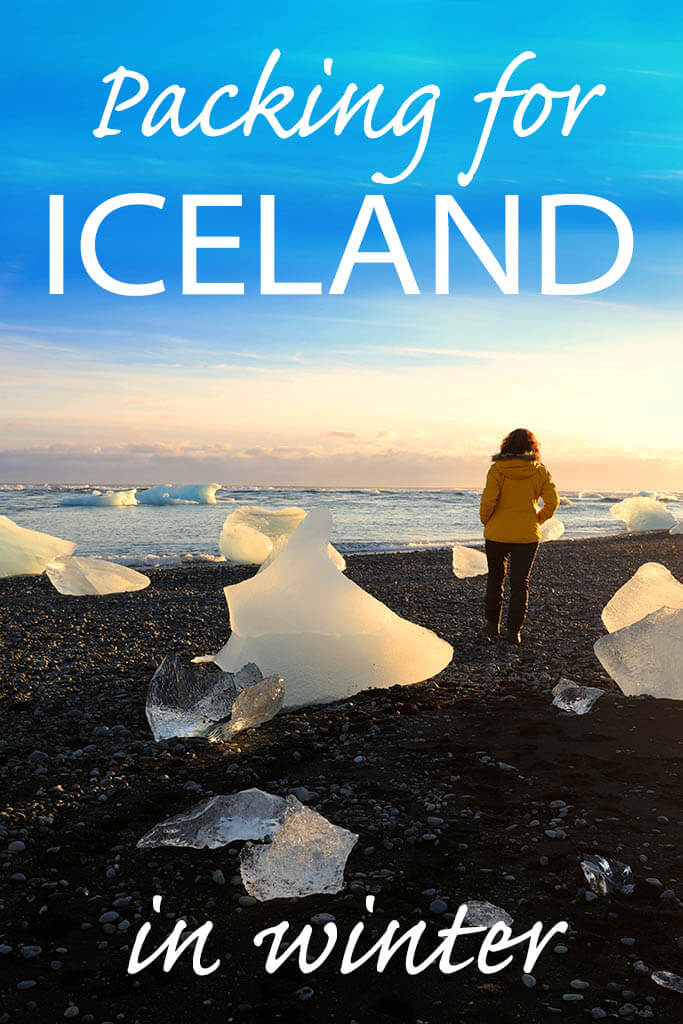

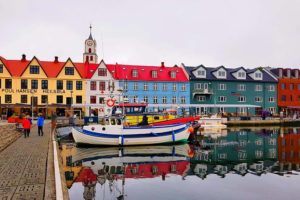



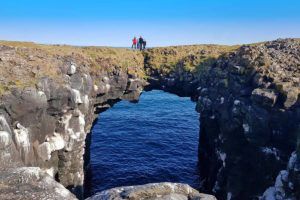

Thank you for this. I thought I was prepared but I’m looking at the temperatures now and I feel unprepared. I will be traveling there this Sept and am very excited. I stay cold so this will be an interesting trip for me. My home is at 70-71 degrees and I still am cold and shivering. I stay bundled up.
Wish me luck!!
Hi Emm, September is generally not that cold in Iceland, so you don’t need to pack as if it’s winter. There is no need for winter boots or winter coats. Take a look at our summer packing list and pack a bit warmer jacket (waterproof outer layer!) and maybe some merino underwear in case you want a warmer layer for your entire body. It’s better to pack a few extra layers than one that’s super thick and warm.
Enjoy your trip!
Thank you for the packing advice, leaving in a month for 2 weeks. 6 days in Reykjavik, 8 days ring road tour. I have all the layers for the tours. Should I bring different clothes/sneakers just for Reykjavik to not look weird?
Hi Dan, you really don’t have to worry about how you look. Nobody cares. Icelanders are very casual and it’s winter, so most people wear really warm outdoor clothes in the city too. I would only pack something ‘dressier’ if you are staying at a very luxurious hotel or plan to dine at high-end restaurants. If anything, you will look quite weird in sneakers in the snow. 😉 Stay warm and enjoy your trip!
Born and raised Minnesotan here, heading to Iceland in late March. We will be using Reykjavik as our hub for the whole trip. I’m not worried about cold, but I’m wondering how rainy/wet it can be in March. We will be doing museums a couple days and just wandering the city about half of our time there. Just trying to gauge how to dress going in/out of shops and museums.
Hi Sara, it can always be very rainy and wet in Iceland, no matter the season. It’s impossible to say in advance, but assume that it will be.
That said, if you are staying in the city, it’s often much easier to hide from the rain – there are plenty of museums and other indoor attractions to keep you entertained in any weather (see also our guide to the best Reykjavik attractions). So when exploring the city, don’t overdo it in terms of layers. A waterproof winter jacket is really a must though. But when you are taking excursions outside the city, I would also wear waterproof pants (either warm winter pants (like ski pants) or rain trousers which you can pull over if necessary.
Hope this helps. Enjoy your trip!
I am planning on going to Iceland in the first week of March- wondering how the weather is like since I am assuming winter is kind of ending, any recommendations or what the weather is like that I should really bring. Between thank you for your blogs, extremely helpful!
Hi Katterin, March is still very much winter in Iceland, so this list is what you’ll need to pack. The main difference with the other winter months is that the days are much longer already, so you have more daylight allowing you to see more/at a more relaxed pace.
Don’t underestimate how cold it can feel and be sure to dress very warm so that you can enjoy your trip to the fullest!
Have a great trip!
Thank you for this comprehensive list – It was very helpful for me as I am planning my trip to iceland
Glad to help, Nikki. Have a great trip!
Hi Jurga,
My husband and I are planning to visit Iceland next year during these date (24th Sept – 7th Oct). As these dates fall between the end of summer and beginning of winter, which season should we be packing for? We both do not really fancy the cold but the main aim for our holidays will be to hunt down the elusive Aurora (if we are so lucky!) 🙂 Your expert advice is truly appreciated, thank you in advance.
Hi Adel, the end of September – beginning of October is a bit in between packing-wise, indeed. You will not need winter boots or ski pants, but I would pack a warmer jacket than in the summer (maybe a 3-in-1 type of jacket) and I’d also take thermal underwear and a really warm sweater too. Rain pants are helpful if you don’t want to be cold and wet all the time, or insulated outdoor pants.
For the rest, waterproof hiking boots, warm socks, gloves (not necessarily the warmest ones like for skiing though), scarfs, a warm (fleece) hat – that’s something that you will definitely want to have with you.
Hope this helps.
Hi Jurga,
My wife and I are going to Iceland in the end of this November. We will be touring Reykajavik and other spots on the island to look for the Northern Light. In your experience, are feet tend to be sweaty inside wool socks and waterproof winter boots? It sounds silly but will actually help us decide how many pairs of wool socks to bring. LOL
Hi Henry, in my personal experience, my feet are always too cold and never sweaty in Iceland, and definitely not if you wear natural wool socks. But that could be different for other people..
Also, the hotel rooms are very warm, so you can easily wash your socks and normally it shouldn’t be a problem to get them dry by the next morning.
Hope this helps. Have a great trip!
I live in the tropics & really scared of the cold. Will be in Iceland in end Oct this year.
I have invested in 2 down jackets – Canada Goose & Moncler for my previous winter holidays and I really like them for keeping me warm. You can probably guess I am not too adventurous from my choice of wardrobe but I will do what I need to cover Iceland in my bucket list. I read October is a wet season & I am wondering if it is a good idea I buy a rain coat to wear it over 2 down jackets even though I know rain & down are bad combination. What do you think? Appreciate your advice in advance.
Hi Kat, lol, every season is a wet season in Iceland. So you really need a waterproof outer layer – always. And not just for the jacket – pants, shoes, and gloves as well.
At the end of October, it can be quite wintery and the wind is very cold, so you need something very warm too. The best thing is to layer including at least one layer of real wool and a waterproof layer on top of all the rest. I guess you could do with a down jacket as one of the middle layers, just make sure that everything is big enough so that you can actually wear everything together, be able to close the zippers, and still move around. 😉
Have a great trip!
Hello – we are going to Iceland in September. I’m looking for help with packing. Would you suggest that for a mid-September trip to the east coast, golden circle and highlands tour we follow your WINTER, or your SUMMER, packing list?
Hi Lani, for September, use the summer list but pack a warmer jacket and a few warmer layers. You’ll definitely want to have a hat, a scarf, and gloves. Winter boots are too warm, but good waterproof hiking boots are a must.
Have a great trip!
Thank You!! Very helpful, I purchase many of the items you recommended for our trip and at one point or another was grateful to have those things with us. The only item that I liked more than your recommendation was a last minute purchase of Pecube Ice Cleats, they appear to be a knock off of the Hillsound FlexSteps. I was worried about something breaking and wanted a backup. They have slightly longer spikes that are spread out wider than the Stabilicers. I found they were better on uneven ice than the Stabilicers.
I cannot tell you how many times the small flashlight I took was necessary with only 6 hours of daylight or so. Dark early mornings to get to things at sunrise and arriving to our accommodations well after the sunset was so handy to have a ready light source.
While I took many glove options, after flying my drone at one snowy site, did not have fingerless gloves with me, poor planning on my part. I had one lady that overheard my issue and directed me to her store’s offerings of gloves, which had a hand knitted icelandic wool, fleece lined fingerless glove with mitten pull overs and a thumb pull over too! I didn’t touch another glove the whole time I was there, even in the cold rain or on the windy whale watching tour.
I reluctantly took a bathing suit and quick dry towel thinking, I didn’t really care about the spa lagoons and stuff. Um, we booked additional days at the lagoons after the first visit. Absolutely amazing. And, I think everyone owes it to themselves to try the polar plunge pool at least once as I, the guy that didn’t want to do any spa days, was amazed by the feeling of the opposite temperature extremes.
Thank you for everything you provided in this article, it was very appreciated.
Glad to help and thanks for sharing your experiences and tips, Ron. Happy to hear that you had a great trip. And yes, those Icelandic pools are really not to be missed. I think I even enjoy them more in the winter than in the summer.
Happy travels!
Hi! Thanks so much for your winter itinerary and clothing suggestions! We are planning a family trip in Nov. This year! We are bringing our 10 year old son, so will wait til closer to time to buy clothing. However my husband found some rechargeable warming gloves (says they are good for 4 hous). They don’t cost a lot and was wondering if this is something you would recommend. My hands and my son’s both get cold easily. And do we need ski masks? We are doing glacier hiking, ice caves and all the other great recommendations. As an American from the south, we aren’t that use to cold! I think we may also do some horseback riding since our flight gets in so early at the first hotel. Hopefully we will see the northern lights over the 8 days we are there! Thanks again for all this great information! Oh…. do the hotels provide shampoo and conditioners? Couldn’t find anything about it and wondering if we should pack our own.
Thanks again!
Hi Beth, I have no experience with rechargeable warming gloves, but coincidentally, I heard someone mention them in our FB group the other day and they said that it worked great in Iceland.
I’m not sure what you mean by ski masks. If it’s ski goggles, no, you don’t really need them for regular activities (and if you go snowmobiling or such, they will be provided). If you mean balaclava, then yes, it can be helpful, but it’s not a must.
If you are not used to cold weather, it’s always better to play it safe and dress warmer than you think you’ll need. In Iceland, the wind can be really hard and it makes it much colder than you would think based on the temperatures alone.
As for hotels, most provide shampoo and soap, but it’s quite rare to find hair conditioners. I usually pack my own.
Hope this helps.
@Jurga, thanks! Yes, I meant balaclava. I will probably end up trying thr warming gloves and also bring hand warmers. I’ll let you know how they work!
Where do I find a printable/pdf version of all this? It’s a necessity!
Hi Michelle, you probably missed the ‘Printable Iceland Winter Packing List’ section in the article (toward the end). You can download the list there.
@Jurga, I see the bullet point list, but all the information in this article is useful, not just the list itself
That’s exactly the point of this article – to provide useful information to our readers. 😉 Surely, there is no need to print all that info. But if you absolutely want to, you can always print it using Ctrl+p.
Have a great trip!
Going to Iceland in November 2022 from Missouri USA and agree with Crislaura, this is the best I’ve found too!! THANK YOU!
Thank you for your kind feedback, Joanne. Enjoy your trip!
I’m going to Iceland in November and this was the best blog I found ! Thank you for putting this together !
Glad to help, Crislaura. Have a great time in Iceland!
This was so helpful! I’m traveling to Iceland in December for my anniversary! We have a golden circle tour and northern lights tour so I’m definitely going to use these tips! Thank you!
Glad to help. Have a great trip!
@Jurga, hi when you did the Golden Circle tour did you wear ski pants, I’m just concerned that we’re sat on a bus and might get too hot
Hi Natalie, when I visited Iceland in winter, indeed, I wore my insulated winter pants (like this) most of the time. I only wore my ski pants on the days when we did longer excursions/hikes. I never took the pants off on the bus or in the car, only the jacket.
It really depends on the weather you get, but if it’s cold and wet, you’ll be glad to have them, especially if you spend a long time outside. It’s a bit difficult to dress/undress every time, but if you are taking a tour with a big bus, it might be possible.
On the other hand, if your tour only foresees very short time outside, you might also be ok with simple rain pants over your regular pants. That way, you can just pull them on if it rains or if you are planning to go very close to the waterfalls. And if it’s dry, you may not even need them at all. If Golden Circle is the only excursion you are planning outside of Reykjavik, check the itinerary carefully. If you are only stopping at the main sights for a few minutes, you might not need ski pants at all.
Have a great trip!
Thank you so much for a wonderful packing list. I am going October 15-22, 2022. Do I really need stablilicers during this week? Should I follow the winter packing list to the fullest? Wasn’t sure if need to pack as heavily since it’s the middle of October. Since I do not check a bag and always carry on when traveling abroad. I will have to get creative 🙂
Hi, the second half of October is a bit tricky indeed. Most of the time, there shouldn’t be much snow or ice yet. So I think you can skip stabilicers.
For the rest, yes, dress for winter (always layer, so that you can adjust). The wind is usually very hard and it feels much colder than you might think just by looking at the weather forecast.
That being said, waterproof hiking boots and wool socks might be sufficient at this time of the year. You probably don’t need ski pants either, but something warm and waterproof sure helps. You can be creative and not overpack.
If you travel with a carry-on, wear the heaviest/ bulkiest things on the plane.
Have a great trip!
Hi im going to iceland in February this year really really stuck do I need snow boots ski trousers etc only going to northern lights and blue lagoon rest of time in city
Hi Elizabeth, you don’t need any special clothing for the Blue Lagoon (apart from swimwear, of course ;)). For the Northern Lights tour, it really depends on the tour and how much time you plan to spend outside. If that’s really the only tour you do, you could probably manage with somewhat thinner clothes (so no ski pants but still thermal underwear under your pants + a warm winter jacket), but if you have to stand outside for hours, your experience will be totally ruined if you aren’t dressed warm enough.
As for the shoes, it’s good to have decent winter boots for the city too – it can be very cold, likely slippery and/or wet too. Good footwear is really a must if you want to enjoy a destination like Iceland in winter.
Have a nice trip!
Thank you for this article, I found it very helpful for figuring out what to pack for myself. My partner, on the other hand, is stumped on what to pack. We live in an area that is known for it’s cold winters and we get lots of snow (we regularly get temperatures below freezing and average 94 inches/240 cm of snow a year). My partner is a person who is naturally very warm. He regularly shovels the driveway in shorts, a tee shirt and sandals. He rarely wears a jacket in winter and doesn’t own a heavy coat. He doesn’t want to get into a situation where he is underdressed for the elements, but he also doesn’t want to bring unnecessary items that he won’t need. What do you recommend for my hot blooded partner?
Thanks!
Hi Kara, I really don’t know what to say. I guess everyone should feel for themselves what they’re comfortable with. My best advice remains the same – layers (at least one in wool), and a waterproof outer layer. The wind in Iceland can make it all feel so much colder than you’d think based on the weather forecast. And if you wear layers, you can always adapt to how it feels. So – just to be safe – I’d say pack more and then in the best case, you won’t need it, but if you are too cold, it’s difficult to enjoy the trip.
I still have to meet one person who was ‘overdressed’ for Iceland in winter.
We get tens of emails from readers every month about this packing list, and all of them say that it saved their trip.
Have a wonderful time in Iceland! And – if you think of it – feel free to leave a comment here afterward and tell us how it went. Maybe it will helo other warm-blooded people like your husband. 😉
Hi Jurga! Thank’s for such an informative post. I’m going to Reykjavík from 5th to 9th January and just really worried about freezing my *ss off! Hahah. Your tips are just so great! Do you think a ski set (with thermal underwear), thermal socks and gloves are going to do the job? We’re going on these three tours: Golden Circle & Blue Lagoon; South Coast Waterfalls, Glacier & Black Sand Beach and Fagradalsfjall Volkano hike & Reykjanes. And also extra Nothern Lights Tours every evening. Do you have any specific tips for these activities? Thanks a lot in advance!
Hi Thaina, yes, ski clothes + all the warm layers underneath should be about right for Iceland in January. You won’t need the ski pants in the city, but they’ll come in handy for the tours you are planning. Waterproof clothes are really a must!
And – just as important – good winter boots (= warm, waterproof, and with a good grip). See also our article with the best winter boots for travel if you are looking for recommendations.
Just one more thing – I don’t know about you, but my ski clothes are quite ‘tight’, with not much room for a warm sweater (or even two) underneath. So you may want to try it all on with all your layers and see if you can still move. 🙂 I always wear a special extra warm waterproof jacket when I travel to the Nordics in winter + my ski pants. But all my ski jackets are too small for what I wear underneath, so I only use those for the actual skiing.
As for the activities you are planning, you’ll be spending lots of time outside and if it’s windy and rainy, you’ll really need warm waterproof layers. At the same time, it will be warm on the bus, so be sure to dress in such a way that you can quickly take some layers off when driving.
For the Northern Lights, keep an eye on the forecast and try to plan your tour on the most promising days. If you book tours we recommend on our website, pretty much all of them have free cancelation up to 24 hrs before the actual tour, so you can book them now and then cancel the ones on the days that don’t look too good. Or book a tour that guarantees a free second retry and be sure to do it in the beginning of the trip, so that you can still find the time for a second try if it doesn’t work out the first time. See this article for suggestions – Iceland Northern Lights.
Have a wonderful trip!
Hi Jurga,
thank you so much for sharing all the useful tips about the weather in Iceland. It is very reassuring to have such an insightful guidance about all the things needed to enjoy many magical adventures in the Land of Fire and Ice. I’m really looking forward to exploring the island in a few weeks time now that the packing list you’ve provided is fully ticked. Best wishes and warmest regards.
Glad to help, Ana. Have a wonderful time in Iceland!
Hi, I found your information really useful but have a couple of questions. Should I take hiking poles and – this is a SERIOUS question – is the coffee served in cafes and restaurants ok? I usually take my Aero press and some coffee with me but would prefer not to. Thankyou Evelyn
Hi Evelyn, whether you need hiking poles depends on which hikes you are planning to do. For the most popular places along the Ring Road, you don’t need hiking poles at all. So I’d only pack them if you are planning any steeper hikes – in winter it can be useful on the easier hikes as well. If you are looking for easy-to-pack hiking poles, here are the ones that we have – the best we’ve ever had and so light and compact that it’s easy to pack them anywhere.
As for the coffee, it’s generally very good in the Nordic countries and I never heard anyone mention that it would be a problem to find really good coffee in Iceland. I guess it will also highly depend on the places where you eat, so I really don’t know what to say. If it’s that important to you, only you can decide if it’s worth packing your own coffee… For us, traveling is also about trying the food and the drinks of the place we visit – it’s part of the experience.
That being said, if you are traveling in the coldest months, I recommend packing a small thermos and taking some coffee/ tea with you from your hotel in the morning. It’s really nice to have a warm drink when you are in the middle of nowhere and want to warm up a bit.
Have a great trip!
Hi I’m going to Iceland in August the 2nd to be exact what clothe should I bring and what camera is better, I will go to Reykjavik which places you would recommend thanks.
Hi Shirley, for August I recommend you check this summer packing list for Iceland. It won’t be very warm, but you don’t need winter boots or an overly warm jacket. Just lots of layers and a waterproof outer layer.
For the camera, it’s really hard to say as everyone’s needs and abilities are different. If you just want good pictures and a very versatile affordable camera, I recommend something like this Panasonic Lumix FZ80 or – a bit more expensive – PANASONIC LUMIX FZ1000 (it has a somewhat better lens).
As for what to do, I recommend just 1 day in Reykjavik and for the rest either rent a car and make a self-drive trip (here we have a very thorough itinerary for your first trip to Iceland) or book day trips (here you can find our hand-picked selection of the best day trips from Reykjavik).
As for what to see in Reykjavik, you can find some suggestions here: What to know when visiting Reykjavik.
Hope this helps. Enjoy your trip!
Will I need ski pants (May 2019)? Will a thermal baselayer under fleece leggings work or will this be a bad idea like jeans? I have a short 3 in 1 jacket.
You don’t need ski pants in May. I suggest light hiking pants with thermal leggings underneath. Ideally you also pack some rain pants to pull over whatever pants you are wearing in case it rains.
Jurga,
Thank you so much for sharing your knowledge so freely! My husband and I are going to be in Hornstrandir from March 2nd to the 10th, and then hope to drive the ring road form Isafjorder back to Keflavik by the 16th (going North!)… Any tips you can offer would be MUCH appreciated. Also, my husband is allergic to wool – any suggestions?
Hi Rachel, sounds like an amazing trip, just be aware that it’s still very much winter in Iceland in March and so you have to be comfortable with driving in extreme winter conditions, especially because you are going North. Make sure to rent a 4WD and not the smallest one either. You may want to take an ice scraper/snow brush with you – they usually don’t come with a rental car. Or get one in Iceland at a local petrol station.
Any other tips – in general, you have to book your accommodations well in advance. I guess it won’t be a problem up North this time of the year, but the south coast between Reykjavik and Jokulsarlon glacier lagoon is extremely popular, so at least there you’d better book asap. Here you can find our suggestions on where to stay along the Ring Road in Iceland.
If you are looking for ideas where to go and what to see, you can find some general itinerary suggestions here and here I have a bit more detailed itinerary for the south coast in winter.
As for the clothing, if your husband is allergic to wool, then I recommend synthetic thermal underwear (something like this). Instead of a wool sweater, he should best look into wearing a couple of warm fleece sweaters over each other and a warm waterproof jacket.
If he can’t wear a woolen hat, there are also warm fleece hats available or – even better – a waterproof trapper hat like this – believe me, it’s not exaggerated for Iceland in winter.
Hope this helps. Enjoy your trip!
Thanks again, Jurga! I have another question that I just can’t seem to get an answer to – can you fly on Air Iceland (Reykjavík to Isafjorder) with chemical handwarmers either in luggage or as carry on? And if not, can they be bought in Isafjorder?
Hi Rachel, I really don’t know. I think – in general – if you have just a few of them for personal use it should be fine. But if you want to be sure, why not try contacting the airline.
In any case, anything you’ll have to buy in Iceland will be multiple times more expensive…
Hi there, we are traveling to Iceland beginning of September and want to know if we wear the same items as you have listed in your blog. Also can you recommend at good backpack for day tour trips to the Golden Circle or out to find the Northern lights. Thank you!
Hi Karin, for beginning of September, you can pretty much our Iceland summer packing list. Just keep an eye on the forecast and maybe pack a somewhat warmer jacket or a thicker sweater and I also advise thermal underwear (also leggings).
As for a backpack, there are so many. I use a 30 liter day backpack from Jack Wolfskin for years already, but once again, there are many others… Make sure it has a rain cover or get one separately. It’s really a must.
Enjoy your trip!
My friend and I are leaving for Iceland next week and your tips have helped tremendously. We knew we needed warm clothing, but some of your tips have been especially helpful . Like
Good to hear that. Dress warm and enjoy your trip!
Jurga, your tips were absolutely spot on and incredibly helpful to us. We were warm, dry and as happy as we could be in blizzards, hail storms, rain and wind (who knew the weather in Iceland could change THAT quickly!). I fell in love with Iceland, particularly it’s stark beauty in winter, and can’t wait to go back when the weather is warmer, the land is greener and the hours of daylight lengthen!
Thank you again!
Thank you so much for coming back to the blog to share your experience, Hallie. Glad to hear that our packing tips helped you enjoy Iceland in winter! If you can, try to visit again in summer, you’ll be amazed – it’s a completely different country!
Hi Jurga,
Thank you so much for all this info. Everything has been very helpful. In regards on where to stay, I will be staying at the Tower Suites with my wife. Do you have any comments on this hotel?
Thank You
Hi James, glad to hear you found this useful.
As for the hotel, I’m not familiar with it, but I looked it up and if you mean this Tower Suites hotel in Reykjavik, then it looks great. Reviews are fantastic, the views look amazing, and the location is ok. A bit of a walk from some places, but in general Reykjavik city centre is so small that it’s not a problem.
Enjoy your trip!
Hi Jurga
We leave for Iceland on Tuesday morning, we have thermals and layers, as well as most of the suggested items. My concern is that I get really hot easily so worried about the transition from outdoors to indoors. If for instance you are going out in Reykjavik for the evening what do you wear as going to be outside walking from the hotel etc and then inside where it is warm. Is there places to store coats/waterproofs etc at places when you go indoors? Thank you
Hi Claire, yes, it can be a bit challenging sometimes, especially at the restaurants in town. Some places will take your coat, some others – you just hang it on the chair…
In general, you need less layers in the city compared to when you spend the whole day outdoors, since you can always go to warm somewhere if need be. So maybe dress a bit lighter when in Reykjavik, so you have less to take off… 🙂
Also, all hotels in Iceland are really war inside, so keep that in mind when packing and take some lighter clothing for when you go for dinner at the hotel restaurant.
Hope this helps. You’re probably overthinking it too much. Just go with the flow and don’t worry about what people think and do what makes sense for you. Enjoy your trip!
Hi Jurga, I am traveling to Iceland this Feb. My first ever trip there. My question is – I have snow pants. Can I use them instead of buying new waterproof skiing pants? Thank you in advance
Hi Prasanna, I also wore my ski pants in Iceland, no reason to buy anything new if your pants are warm and waterproof. If they aren’t waterproof, then I’d consider either getting new warm waterproof winter pants or rain pants that you can wear over your pants in case of heavy rain/snow.
that you can wear over your pants in case of heavy rain/snow.
Hi Jurga, I am going to Iceland next week (Christmas). Do I really need crampons? I will be staying in Reykjavik and booked two day trips – golden circle and south coast. Thank you
Hi James, you don’t really need crampons, but stabilicers (see some examples in the post above) can be useful, especially around the waterfalls where it’s often like an ice skating rink in winter.
If you visit Golden Circle, you’ll be visiting Gullfoss waterfall and along the South Coast you will probably go to Selfoss and Seljalandsfoss. You can still see all these waterfalls from further away if it’s too slippery to get closer, but sometimes even the car parkings are covered with ice… You could potentially get stabilicers online, keep them in the original packaging, and send them back afterwards if you end up not needing them. 😉
Hi Jurga, I just printed your packing list – it’s so helpful! Thanks for all the suggestions, we would have never thought to bring several pairs of gloves or crampons. Thanks again.
Glad to hear you found it useful, Mar. I made that printable list to help people to quickly check that they didn’t forget something when actually packing the suitcase. It’s so easy to forget something essential, and Iceland isn’t the best place to come unprepared in winter.
Enjoy your trip!
Jurga;
What is the difference between crampons and stabilicers?
Thanks as always!
Hi Gwen, crampons are in general much heavier and with longer metal ‘claws’. They are more meant for activities like glacier hiking or ice climbing and normally if you do a tour, crampons will be provided.
are in general much heavier and with longer metal ‘claws’. They are more meant for activities like glacier hiking or ice climbing and normally if you do a tour, crampons will be provided. .
.
Whereas stabilicers are lighter, with just short metal spikes, more meant to walk around on icy pavements in town or for some lighter winter walking. They don’t cost that much, don’t take lots of space in your luggage, and are easy to quickly slip on over your shoes. So for sightseeing in Iceland in winter, I recommend stabilicers
Hi, I’m on my way to the airport now and of to Iceland. Glad I found your packing tips yesterday night as the first thing I did in the morning was to completely repack my rucksack! I guess it saved me lots of tears and money! Thanks for the great tips on what needed in November. I really didn’t think to expect full blown winter at this time. It’s my first time in Iceland. It seems what I’m taking with me in terms of clothes is really most of my winter / skiing gear I had in Norway last year. I hope it will be relatively good weather. I’m going there on my own and plan to spend 4 days. Found 2 day trips that sound interesting.
Thanks again for good tips. Really helpful.
Hi Kate, your comment made my day. Glad you decided to check for advice last minute as it’s indeed winter in Iceland already. I even saw people posting pictures of snow the other day, so I think you’ll be glad with all the winter and ski clothing.
If you are still looking for some ideas for day tours, you can find our hand-picked selection here. Don’t miss the South Coast, and hopefully the skies clear up a bit and you get to see auroras.
Have a great trip!
Hi there. I am going to Iceland 2 weeks time. I found your tips. Very helpful. Didn’t know what to wear. Off to buy some Thermals!!!!
Ha ha, you’ll definitely need thermal underwear, Liz. And lots of wool. Glad you found this post useful and I hope it will help you to enjoy your Iceland winter trip even more!
I am visiting Iceland in 2019, May 1-8, should I be thinking winter packing or summer? I suspect that I need to be prepared for both cold and less cold weather…Thanks, Liz
Hi Liz, beginning of May I’d go with the winter packing list and several layers. Just in case you get extremely lucky with the weather, you can always take one layer off, but be prepared for the cold.
Depending on where you go, if it’s just South of Iceland, you might be ok with just regular waterproof hiking boots (so not necessarily winter boots), but make sure you pack some wool socks.
I’m leaving for Iceland in just a few weeks, which will be early/mid March. With all the wind in winter, combined with rain and snow, are sunglasses sufficient during glacier hikes? I would not like to get wind and rain in my eyes, plus my glasses often fog up from my breath. Would you recommend using ski goggles instead?
Also, I’ll be renting a car, I assume that the rental SUV will already be equipped for the winter for driving on the ring road, notably winter/snow tires. Is that a safe assumption or do I need to request it from the rental agency?
Hi Isabelle, I really don’t know about the glasses. For me, sunglasses were more than enough and I haven’t seen anyone with ski googles. But if your eyes are very sensitive, then you probably know best what you need. Maybe consider sports sunglasses?
As for the car, I also think that they will be equipped with winter tires in this period, not sure about stud tires though. You could always give them a call and ask, it never hurts.
We are planning a trip to Iceland I. November this year and I have been reading all your comments and advise, they are very helpful and giving us a great idea of what to expect, thank you so much
We are renting a car and already have a place to stay, all we need us plan our itinerary for one week, there are so many things to do, choosing the best is the trick here!! Again Thsnks..
Thanks for the feedback, Nora. Enjoy your trip!
When is the best time to see the Northern Lights?
September through March.
Is it the temperature or the wind that makes it so cold?
It’s more the wind, David. The temperatures are also not warm in Iceland in winter, but nothing compared to Canada or Alaska. But the windchill factor can be so bad as nowhere else I ever been to.
Hi! I wondered which brand the yellow jacket you’re wearing in the photos above? I love it!
Hi Belle, it’s Jack Wolfskin Nova Scotia jacket, but I really don’t know if you still find the same color. 🙂 You know how these brands are – changing collections multiple times every year. 🙂 But yes, it was a great choice for Iceland in winter as it brightened up all the pictures :). I found something similar for you here, not sure how warm it is, and the yellow is maybe too yellow :).
Hello, there will be four of us traveling right after Christmas to Iceland. After reading the blogs, I see what needs to be packed for this trip. Regarding weather and activity, are all the tours still open at this time or are they cancelled due to weather? How is transportation there? I heard buses are best to get from to to fro . I also heard about expensive food and drink. We are from north jersey so we are used to more expensive meals but how much would a meal for two with several drinks cost approximately? As far as currency it looks like ten krona to one US dollar. Is that correct? I was told tipping is not necessary as gratuities are included. Is this correct? Any goo tips for us at this particular time of travel we should know? ThAnkyou
Hi Mike, I will have to refer you to some of my other blog posts for winter travel. Check our winter itinerary for ideas of what you can do. Check this if you rather stay in Reykjavik and do day tours. Normally, all the tours that I mention in my posts run in winter. Some may not go daily, but you can see it in the calendar when you book. Yes, it sometimes happens that they get cancelled due to the weather, but not often. If you want to do any tours, book ASAP – Iceland is very popular and definitely around Christmas/ New Year. Lots of things (tours, hotels, car rental) get fully booked, so if you still need any of that, book now.
As for transportation, do not count on public transport as it will really not get you anywhere in terms of sightseeing outside the city. You have to either rent a car or do tours. If you don’t have a car and have to get to the city from the airport, make sure to book an airport transfer in advance. It only costs around 25USD. I just saw someone complain on Facebook that they took a taxi to Reykjavik and paid almost 200 USD.
As for the meals, it depends on where you are. In Reykjavik and some other towns you will have more choice in terms of restaurants, but even then it’s difficult to find any good meal under 20-30 USD. often, you will pay 35-50USD for a main course at dinner, especially in remote areas. Alcohol is very expensive too (10-12 USD for a beer in the restaurant isn’t uncommon). 3-5 USD for a soft drink. Don’t worry about tipping – it’s not needed. They won’t say no of course, but it’s not a must at all.
1000 ISK is (roughly) about 10 USD at the moment, so divide all the prices by a hundred and it will give you a good idea how much everything costs.
Hope this helps.
Hi Jurga,
I’m glad that I found your blog, its such in details and helpful, My trip to Iceland shall be Next year Feb 16th
May I know is Reykjavik Windy Winter or Dry Winter? I’ve been to Rovaniemi , the winter there is Dry and not as cold as we predicted, Is Iceland winter colder than other part of Europe in Feb?
Hi, temperatures in Iceland in winter are not as cold as you would expect. I think it hardly ever gets below -10°C, usually around 0°C. However, it is indeed very windy and therefore feels much colder than the temperatures would make you think.
Also, it doesn’t snow that much, but you can get lots of winterly rain and ice. Add the wind to that and it’s as cold as it gets.
That’s why you need waterproof clothing and waterproof shoes. Layering is the best way to make sure that you are prepared for the ever-changing weather.
I plan to travel to Iceland from October 29th to the 5th of November.
1. Curious of the road conditions from Reykjavik to Hofn ?? If we would have time to travel to Egilisstadir or not and still drive back to Reykjavik by Saturday?
2. Any advice on domestic flights in order to cut down on car time? We thought of trying to visit Lake Myvan and fly back from Akureyri ?
3. How much time to allow for the Golden Circle?
4. Travel from Airport (Kef) to Reykjavik cost if bus/shuttle?
5. As another couple will be renting a car coming in a day after me.
Hi Laurie, I really have no time to look into your itinerary, but here are some answers:
1. Road conditions – you won’t know till you get there. I would think that in that period it should generally be ok. For driving times it’s best to use Google maps – they are usually pretty accurate.
2. The best way to get to/from Akureyri in winter is indeed by flying from Reykjavik.
3. Golden Circle – you’ll need half a day + the time to get there and back.
4. You can find more info about airport transfers here.
Thanks Jurga that’s really useful. Can’t wait ???
Great post thanks so much for the tips, I was having a bit of a stress packing… as always!! A couple of questions, I have walking boots or walking trainers – do you think I boots are a better option? Also any tips on what food to take I heard it was pretty expensive so was thinking of taking my own. Thanks
Hi Becky, whether you need hiking boots will depend on your itinerary. If you plan on doing some serious hiking, then yes. Otherwise you will be ok in walking shoes, just make sure they are waterproof and somewhat anti-slip, even if you only do short walks to the main highlights.
I have no experience with taking food into Iceland. I think I took a package of cookies and never ate it :). There are quite some shops/ petrol stations/ small cafes along the Ring Road now, especially in the South, and the prices are generally ok. Dinner in remote areas is quite expensive though, as there is not much choice or alternatives.
Enjoy your trip!
Hi Jurga, I’m reading your tips and wondering what to pack when you’re sharing one suitcase with four people. We’re flying WOW Airline and WOW suits this carrier in so many different ways. The airfare was amazing even after paying for seat selection and one carry on for our family trip with two tall adult children. But that is what’s stressing me out. How do we get enough clothes for the four of us into one checked bag. They even charge for a second personal carry on now…. WOW! So what do you think is most important to bring? We get about 10lbs each in the checked bag.
Wow! 🙂 I think you can always still book an extra bag after you already booked the tickets. Most low-cost companies allow it. So check that first.
But anyway. Back to packing. I actually think it’s possible (we travelled to Australia for 5 weeks with 2 suitcases for the 5 of us, with temperatures ranging from 50°F to way over 100°F in different regions we covered). Take just one pair of shoes – wear them. Pack a waterproof jacket – wear it as well. One sweater (fleece = light and warm) per person – wear it. Pack one extra fleece sweater, maybe an extra pair of pants. For the rest it’s just some underwear and t-shirts really (which can be washed in the hotel in the evening if need be), swimsuit (but leave the towels and even flip-flops at home). A buff, gloves, toiletries (as little as possible – you can use hotel amenities or buy what you need upon arrival)… It’s not easy, but feasible even with 10lbs. Don’t take anything that is not 100% necessary. Make sure that all your clothes match (so no pants that only fit with that sweater and situations like that ;)) and that you can layer the sweaters/jacket if necessary. You’ll be surprised how little you actually need. Hope this helps! Curious to see how you manage it! 😉
I am returning from Iceland today. Winter had just arrived about the middle of my trip. Jurga’s packing tips really saved my life.
Jillian, I flew with Icelandair from Chicago O’hare to Keflavik. They allow you 2 free checked bags, one carry-on and a personal item. The carry on bag I chose was an Osprey Transporter 40 duffle/backpack. It fit perfectly in the overhead compartment, and I had it packed full. I would say the type of luggage you would need may also depend on what type of vehicle you will be travelling in and if your travelling companions will need space for their luggage also. These were the big deciding factors for me. The large roller suitcases can take up a lot of room in the back of your car and could make it difficult to situate other luggage.
Be sure to take Jurga’s advice about what to pack. The most useful things I had on the trip were my waterproof pants and my rain/wind shell jacket. You don’t want to have to buy the expensive stuff in Iceland’s gift stores. My husband did not take my advice and found out the hard way that he needed waterproof instead of water resistant clothes.
Thanks a lot for your feedback, DeAnna. Glad to hear that my tips made your trip more enjoyable. How was the trip itself?
Sorry to hear about your husband though. I saw so many people in wet jeans during our trip, I don’t know how they handled it. It’s so much easier and cheaper to buy the right clothing (and shoes!) before you leave – prices are really high in Iceland and even more so in tourist areas.
It really was everything I hoped it would be! The weather was about as nice as you can expect it to be in November. Some sunshine, some rain, snow and cold strong wind. The northern lights were not very strong while I was visiting though. We saw them very faintly one night while staying in Kirkjubæjarklaustur. My favorite memory of the trip was climbing the cliff behind the town in the dark to get a better view of the lights. We were completely alone up there, the moon was full, and we could see everything for miles in all directions bathed in moonlight. Simply the most incredible view even without the northern lights.
Wow, this sounds amazing. Thanks for sharing, DeAnna.
Does anyone have recommendations about the type of luggage that is best? I am torn between my standard large roller suitcase or a large camping type backpack.
Hi Jillian, I think that DeAnna is right – you should consider what means of transport you will be using in Iceland before deciding what type of luggage to take with you. I took a large duffel bag with wheels to Iceland, but it’s the same luggage we use for most of our trips. We’ve abandoned hard shell suitcases years ago, because duffel bags are just easier to stack in the trunk of the car when doing road trips, and especially now that we travel with 5 people. But if trunk space is not an issue, then it really doesn’t matter.
Helpful tips! Can’t wait to go shopping for this trip soon. Thanks a bunch.
Any excuse is good to to update your wardrobe, isn’t it? 😉 Same here – I buy most clothes when preparing for trips. Advice for Iceland – buy bright colours. Landscape can be really b&w in winter if the weather is less good and your bright jacket will improve all your pictures! Or at least that’s what everyone keeps telling me about my yellow jacket in Iceland…
Thanks for the advice, Jurga. I found your article very useful. Myself and a group of friends are travelling south Iceland for a week this coming November, and I’m already so anxious about the trip. My entire suitcase will just be coats I’m afraid. I’ve already got the thermals and rain gear checked off the list, but I’ve got to get something heavier to help fight the wind and keep me from blowing away.
Glad you found my tips useful, DeAnna. You made me laugh ‘entire suitcase will be just coats’. 🙂 Pick right and one is enough. And don’t forget at least 2-3 layers underneath. You can click on the yellow jacket picture to see what I wore in Iceland in November – to give you an idea. What you are looking for is a lightweight wind- and waterproof jacket with winter insulation. Have fun in Iceland (and don’t blow away)!
We visited last February and wore jeans in Reykjavik, but the wind was very strong and cold. I should have packed the thermic undies.
I’m with you on this one, Tatjana. I also wore jeans in Reykjavik, in combination with thermic underpants and three layers of shirts/sweaters + windproof winter jacket (we visited in November). It was still cold, but in town you can always find a place to warm up. Outside of town I wore my winter pants (kind of skiing pants actually) with thermic underwear and it was bearable. People with jeans were really suffering, especially at the waterfalls where they got wet. And we didn’t even have rain – can’t imagine how cold it would be if the jeans would get wet in the rain in such temperatures.
We are going in 3 weeks time for 2 weeks, I have found this absolutely invaluable advise.
Thanks
Thanks, Mark. Glad you found it useful. Have fun in Iceland!
My friend and I are leaving for Iceland next week and your tips have helped tremendously. I feel that I am well prepared now and ready for Icelandic winter. We knew we needed warm clothing, but some of your tips have been especially helpful.
Have a good trip. You will love Iceland! And thanks for reading and for your feedback – highly appreciated!